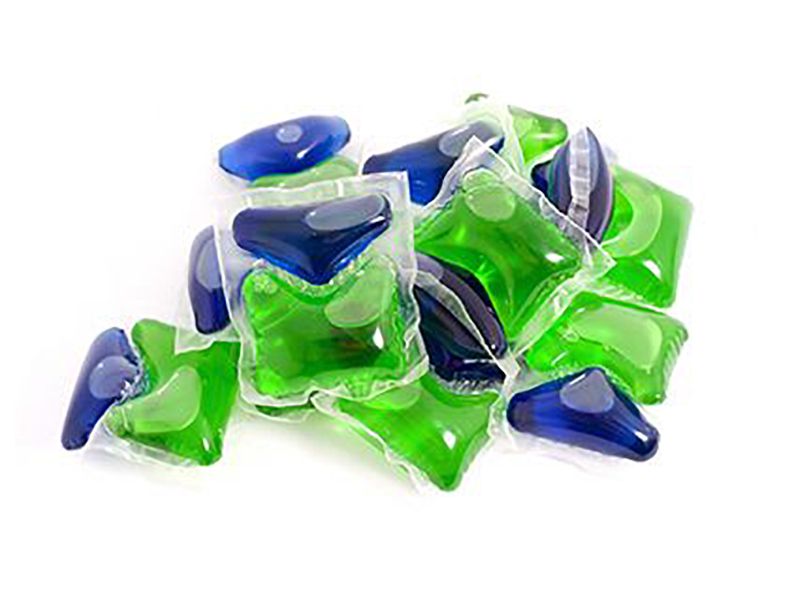

Laundry Detergent Pods Linked to Eye Burn Danger in Kids
Nearly 500 such injuries occurred in 2015, study reportsThursday, February 2, 2017

THURSDAY, Feb. 2, 2017 (HealthDay News) -- Liquid laundry detergent pods may be convenient, but young children are suffering vision-threatening burns from the chemicals inside them in increasing numbers, a new study finds.
Between 2012 and 2015, more than 1,200 preschoolers in the United States suffered eye burns from these single-use detergent pods. In 2012, only 12 such burns were reported. By 2015, that number was almost 500.
"These pods look like toys, they look like candy, and kids are finding them, playing with them, puncturing them, and the chemicals inside the pods are getting into their eyes," said lead researcher Dr. R. Sterling Haring, from the Johns Hopkins University Bloomberg School of Public Health in Baltimore.
Injuries most often occur when children play with the detergent pods and they break and the liquid squirts into their eyes. Burns also happen when kids get the soap on their hands and then touch their eyes, Haring said.
"Laundry detergent pods are playing a large and growing role in chemical eye burns among small children," he said.
As a proportion of all chemical burns to the eye among kids, burns from these liquid laundry pods rose from less than 1 percent in 2012 to 26 percent in 2015, Haring said.
"I am expecting the number of burns in 2016 to be higher than 2015. These numbers have grown every year," he said.
The American Cleaning Institute (ACI), an industry trade group, said in a statement that the study looked at accidents that occurred before the industry introduced a voluntary safety standard for these products.
Most detergent manufacturers by the end of 2016 have already made changes to their products to conform to a new set of guidelines, the ACI said. These new guidelines call for pods that can withstand squeezing pressure from a child. The pods also have a bitter substance on their outer layer to keep children from swallowing their contents. And packaging of the pods is now opaque so the laundry pods can't be seen from outside the packaging, the group said.
The industry will look at data from 2017 to see if the changes helped prevent injuries to children, the ACI statement said.
For the study, Haring and his colleagues used data from the U.S. Consumer Product Safety Commission to look for eye injuries caused by chemical burns or conjunctivitis among 3- to 4-year-olds between 2010 and 2015.
One of the reasons laundry pods can be dangerous is that chemicals in the pods are alkaline rather than acidic, Haring said. Alkaline chemicals are more likely to cause lasting damage than acidic chemicals, he said.
"The detergent can burn the cornea, leaving a scar that can impair vision or potentially cause blindness," Haring said. "In the most severe cases, children may need a corneal transplant to restore vision."
If a child has a chemical burn, step one is to rinse the eye with cool water under a faucet for 20 minutes, Haring said.
"Call 911 or take the child to an emergency room, but do it after you rinse the eye for 20 minutes," he said. "That is the first step, and that's the most important step. The longer those chemicals sit on the eye, the higher the likelihood they are going to leave a lasting burn and threaten vision."
Dr. Zenia Aguilera, a pediatric ophthalmologist at Nicklaus Children's Hospital in Miami, agreed. "If an accident happens, the most important thing is to wash the eye with tap water," she said.
"These chemicals are so concentrated, it makes them more likely to cause injury," Aguilera said.
"These injuries usually heal without any scaring, but it's extremely painful," she added.
As with any chemical, these laundry pods should be kept away from children, Aguilera advised.
Haring agreed, and said preventing these chemical burns starts with keeping the pods in sealed containers and away from children. "The best thing that can be done today is to put these pods out of reach, out of sight," he said.
The report was published online Feb. 2 in the journal JAMA Ophthalmology.
SOURCES: R. Sterling Haring, D.O., M.P.H., Johns Hopkins University Bloomberg School of Public Health, Baltimore; Zenia Aguilera, M.D., pediatric ophthalmologist, Nicklaus Children's Hospital, Miami; Feb. 2, 2017, JAMA Ophthalmology
HealthDay
Copyright (c) 2017 HealthDay. All rights reserved.
News stories are written and provided by HealthDay and do not reflect federal policy, the views of MedlinePlus, the National Library of Medicine, the National Institutes of Health, or the U.S. Department of Health and Human Services.
- More Health News on:
- Child Safety
- Eye Injuries
- Household Products



























.jpg)












No hay comentarios:
Publicar un comentario